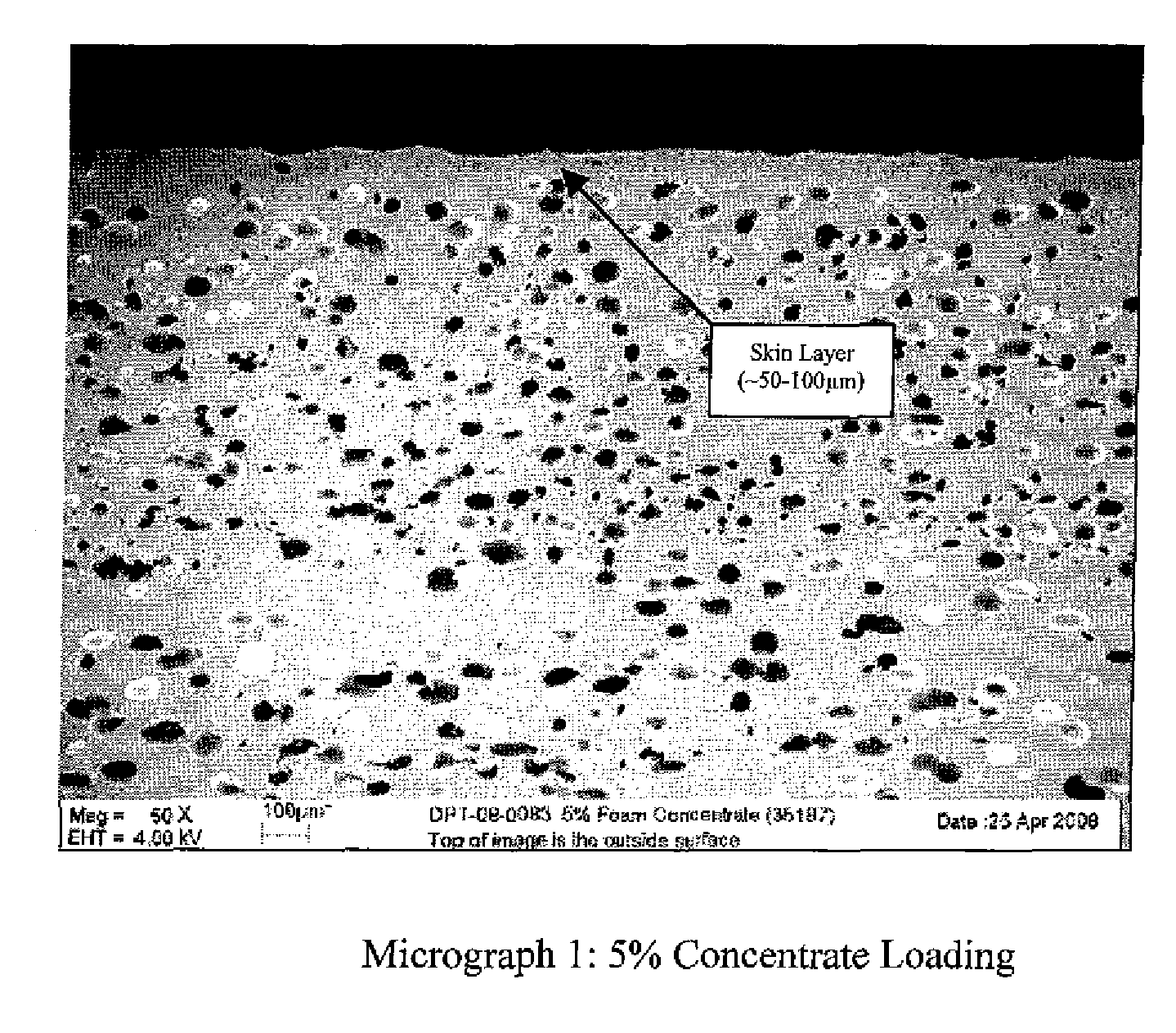Foamed polyvinylidene fluoride structure
a polyvinylidene fluoride and polyvinylidene technology, applied in the field of foamed fluoropolymer, can solve the problems of poor melt strength, limited foaming of pvdf, and high density of pvdf, and achieves the effects of reducing the density of pvdf, reducing the foaming rate, and improving the foaming ra
- Summary
- Abstract
- Description
- Claims
- Application Information
AI Technical Summary
Benefits of technology
Problems solved by technology
Method used
Image
Examples
example 1
[0072]A ⅜″ KYNAR PVDF foam tube with a density of 1.213 g / cc, which is a weight reduction of 32%, was created using the following procedure.
[0073]A mixture of 5% master batch of concentrate that consists of 10% small azodicarbonamide chemical foaming agent, 1% nucleating agent with a surface area of 22 m2 / g, and 89% KYNAR 2821 base resin, which has a melting point of 140-145° C. and melt viscosity of 12.0-20.0 Kpoise, and 95% KYNAR 2800, which has a melting point of 140-145° C. and melt viscosity of 23.0-27.0 Kpoise, was prepared.
[0074]The screw is a 1.5″ diameter general purpose metering screw with a 3:1 compression having a L / D of 26:1.
[0075]The pin and die was attached to a two-leg spider die, with a port to allow airflow through the spider leg into the center of the tube. To make ⅜″ tubing with a 0.040″ wall thickness a die of 0.397″ inside diameter and a pin of 0.306″ outside diameter was selected. This pin and die will produce a draw balance of 1.021 and a draw down ratio of 1...
example 2
[0077]KYNAR PVDF foam ⅜″ tubes were extruded with 0.040″ wall by adding 10% master batch with and without nucleating agents to KYNAR 2800 base resin, which has a melting point of 140-145° C. and melt viscosity of 23.0-27.0 Kpoise. The nucleating agent master batch was CaCO3 with surface area of 22 m2 / g. The chemical foaming agent in the master batch was large particle size azodicarbonamide. The master batch without nucleating agent had 10% chemical foaming agent and 90% KYNAR 2821, which has a melting point of 140-145° C. and melt viscosity of 12.0-20.0 Kpoise. The master batch with the nucleating agent had 1% CaCO3, 10% chemical foaming agent and 89% KYNAR 2821-10. The materials were processed in a 1.5″ single screw extruder with the following process conditions (Table 2)
TABLE 2HeadLineWaterExt.BarrelBarrelBarrelBarrelDie 1Die 2Die 3Press.LoadSpeedTempSpeed1 (° F.)2 (° F.)3 (° F.)4 (° F.)(° F.)(° F.)(° F.)(psi)(%)(ft / min)(° F.)(RPM)3153553804053303153151700569.69010.3
The study show...
example 3
[0078]A ⅜″ tube with 0.035″ wall thickness was made using 10% p-toluenesulfonylsemicarbazide chemical foaming agent master batch from ROWA Group USA and 90% KYNAR 2800-00, which has a melting point of 140-145° C. and melt viscosity of 23.0-27.0 Kpoise. The materials were processed in a 1.5″ single screw extruder at the following processing extruder conditions as shown in Table 3.
TABLE 3LineWaterExt.Barrel 1Barrel 2Barrel 3DieSpeedTempSpeed(° F.)(° F.)(° F.)(° F.)(ft / min)(° F.)(RPM)3553754003408909-13
The barrel zone 4 temperatures were varied. The following properties (Table 4) were observed for the varied temperatures.
TABLE 4Barrel 4Density% Weight° F.(g / cc)ReductionSurface Finish4350.90450%Rough4151.38223%Smooth4051.52415%Very Smooth
PUM
| Property | Measurement | Unit |
|---|---|---|
| thick | aaaaa | aaaaa |
| weight percent | aaaaa | aaaaa |
| weight percent | aaaaa | aaaaa |
Abstract
Description
Claims
Application Information
 Login to View More
Login to View More - R&D
- Intellectual Property
- Life Sciences
- Materials
- Tech Scout
- Unparalleled Data Quality
- Higher Quality Content
- 60% Fewer Hallucinations
Browse by: Latest US Patents, China's latest patents, Technical Efficacy Thesaurus, Application Domain, Technology Topic, Popular Technical Reports.
© 2025 PatSnap. All rights reserved.Legal|Privacy policy|Modern Slavery Act Transparency Statement|Sitemap|About US| Contact US: help@patsnap.com


